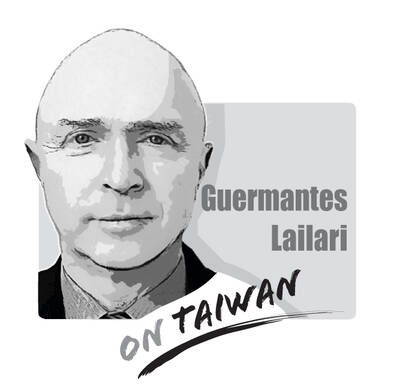Last month, the Chinese Ministry of National Defense released its 10th defense white paper, titled China’s National Defense in the New Era. Due to the ministry spokesman’s harsh responses to journalists’ questions at the event, international media focused mainly on China’s threat to take Taiwan by force, ignoring the message between the lines.
In a section of a little more than 300 words, China expressed its strong opposition to any kind of “split,” reserved the option of taking all necessary measures and pledged to safeguard “national unity” at all costs.
ECHOING XI’S SPEECHES
A closer look shows that the section is a compilation of Chinese President Xi Jinping’s (習近平) speeches at events marking the 90th anniversary of the People’s Liberation Army (PLA) in August 2017, the opening of the Chinese Communist Party’s (CCP) 19th National Congress in October 2017 and the 40th anniversary of issuance of “Message to Compatriots in Taiwan” on Jan. 2.
The publication simply restates China’s determination. Rather than saber-rattling, it is more like a white paper pledging loyalty to the CCP.
Despite all the tough wording, Chapter 2, “China’s Defensive National Defense Policy in the New Era,” includes a section titled “Never Seeking Hegemony, Expansion or Spheres of Influence.”
STRATEGY SHIFT
This section uses the Chinese cultural tradition of “considering peace and harmony as fundamental” as a metaphor to imply that the defense policy is returning from a proactive one to former Chinese leader Deng Xiaoping’s (鄧小平) path of “concealing one’s strengths and biding one’s time.”
Since early this year, China has dealt with the West’s attack on Huawei Technologies Co and boycotts of the Belt and Road Initiative by some Asian and African nations.
To ease concerns about the “China threat theory,” Beijing remained low key when reporting its deep-sea formation training in the Central Pacific Ocean early this year, and the passage of the Liaoning aircraft carrier strike group as it approached Guam and then traveled south of the Philippines before entering the South China Sea in June.
The launch of its self-built aircraft carrier was also postponed from Naval Day on April 23 to until after Army Day yesterday.
These moves were made to change the international perception of the PLA as a threat and a challenge to a bringer of security and opportunities.
China’s defense budget, which at best can serve as a reference only, shows that PLA personnel costs have declined by 4.1 percent since 2010 and its operational costs have dropped by 3.8 percent. The money has gone into military investments, creating a giant leap in its navy, air, rocket and strategic support forces.
This presents the Taiwanese military with a difficult fact: Increased military strength does not lie in the effectiveness of the recruitment system and a balance between the armed forces, but in key investments based on Taiwan’s priorities in face of the enemy threat.
As the PLA conceals its strengths, Taiwan’s military must never be content with having a “hedgehog” strategy — which has so far proven to be effective — and should focus on planning, researching and developing asymmetric “offset” strategies, tactics and weapons to maintain peace in the Taiwan Strait.
Lu Li-shih is a former instructor at the Republic of China Naval Academy and former captain of the ROCS Hsin Chiang.
Translated by Eddy Chang

There is much evidence that the Chinese Communist Party (CCP) is sending soldiers from the People’s Liberation Army (PLA) to support Russia’s invasion of Ukraine — and is learning lessons for a future war against Taiwan. Until now, the CCP has claimed that they have not sent PLA personnel to support Russian aggression. On 18 April, Ukrainian President Volodymyr Zelinskiy announced that the CCP is supplying war supplies such as gunpowder, artillery, and weapons subcomponents to Russia. When Zelinskiy announced on 9 April that the Ukrainian Army had captured two Chinese nationals fighting with Russians on the front line with details
On a quiet lane in Taipei’s central Daan District (大安), an otherwise unremarkable high-rise is marked by a police guard and a tawdry A4 printout from the Ministry of Foreign Affairs indicating an “embassy area.” Keen observers would see the emblem of the Holy See, one of Taiwan’s 12 so-called “diplomatic allies.” Unlike Taipei’s other embassies and quasi-consulates, no national flag flies there, nor is there a plaque indicating what country’s embassy this is. Visitors hoping to sign a condolence book for the late Pope Francis would instead have to visit the Italian Trade Office, adjacent to Taipei 101. The death of
The Chinese Nationalist Party (KMT), joined by the Taiwan People’s Party (TPP), held a protest on Saturday on Ketagalan Boulevard in Taipei. They were essentially standing for the Chinese Communist Party (CCP), which is anxious about the mass recall campaign against KMT legislators. President William Lai (賴清德) said that if the opposition parties truly wanted to fight dictatorship, they should do so in Tiananmen Square — and at the very least, refrain from groveling to Chinese officials during their visits to China, alluding to meetings between KMT members and Chinese authorities. Now that China has been defined as a foreign hostile force,
On April 19, former president Chen Shui-bian (陳水扁) gave a public speech, his first in about 17 years. During the address at the Ketagalan Institute in Taipei, Chen’s words were vague and his tone was sour. He said that democracy should not be used as an echo chamber for a single politician, that people must be tolerant of other views, that the president should not act as a dictator and that the judiciary should not get involved in politics. He then went on to say that others with different opinions should not be criticized as “XX fellow travelers,” in reference to